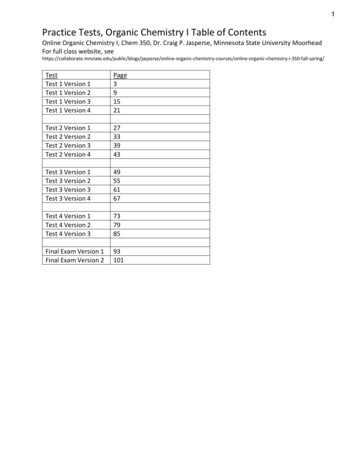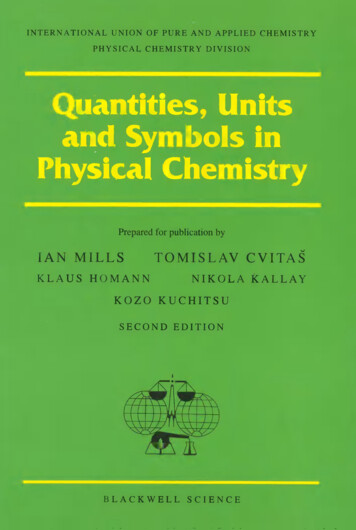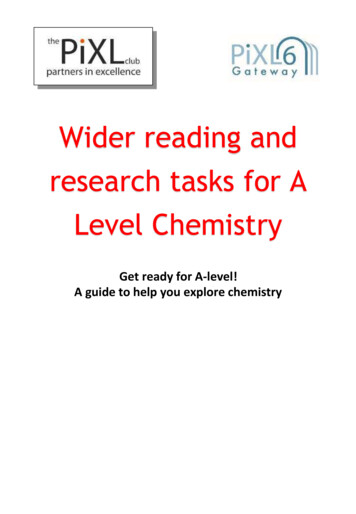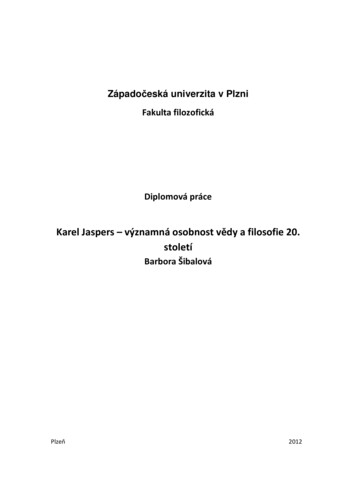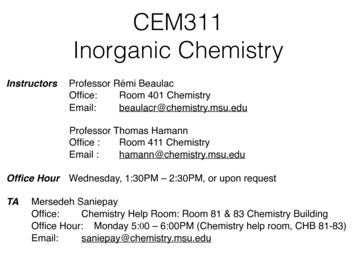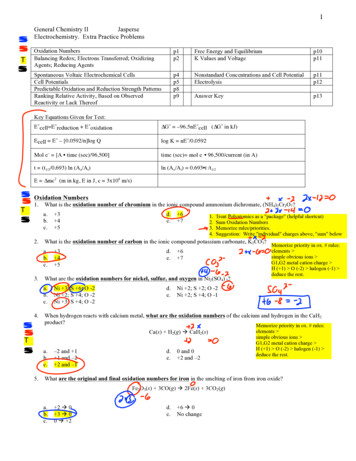
Transcription
1General Chemistry IIJasperseElectrochemistry. Extra Practice ProblemsTOxidation NumbersBalancing Redox; Electrons Transferred; OxidizingAgents; Reducing Agentsp1p2Free Energy and EquilibriumK Values and Voltagep10p11Spontaneous Voltaic Electrochemical CellsCell PotentialsPredictable Oxidation and Reduction Strength PatternsRanking Relative Activity, Based on ObservedReactivity or Lack Thereofp4p5p8p9Nonstandard Concentrations and Cell PotentialElectrolysisp11p12Answer Keyp13Key Equations Given for Test:E cell E reduction E oxidation G –96.5nE cell ( G in kJ)Ecell E – [0.0592/n]log Qlog K nE /0.0592Mol e– [A time (sec)/96,500]time (sec) mol e 96,500/current (in A)t (t1/2/0.693) ln (Ao/At)ln (Ao/At) 0.693 t /t1/2E mc2 (m in kg, E in J, c 3x108 m/s)Oxidation NumbersT1.What is the oxidation number of chromium in the ionic compound ammonium dichromate, (NH4)2Cr2O7?a.b.c.2. 6 71.2.3.4.Treat Polyatomics as a "package" (helpful shortcut)Sum Oxidation NumbersMemorize rules/priorities.Suggestion: Write "individual" charges above, "sum" below 3 4 5d.e. 6 7What are the oxidation numbers for nickel, sulfur, and oxygen in Ni2(SO4) 3?a.b.c.4.d.e.What is the oxidation number of carbon in the ionic compound potassium carbonate, K2CO3?a.b.c.3. 3 4 5Ni 3; S 6; O -2Ni 2; S 4; O -2Ni 3; S 4; O -2d.e.Ni 2; S 2; O -2Ni 2; S 4; O -1When hydrogen reacts with calcium metal, what are the oxidation numbers of the calcium and hydrogen in the CaH2product?Ca(s) H2(g) ! CaH2(s)Ta.b.c.5.Memorize priority in ox. # rules:elements simple obvious ions G1,G2 metal cation charge H ( 1) O (-2) halogen (-1) deduce the rest.–2 and 1 1 and –2 2 and –1d.e.0 and 0 2 and –2Memorize priority in ox. # rules:elements simple obvious ions G1,G2 metal cation charge H ( 1) O (-2) halogen (-1) deduce the rest.What are the original and final oxidation numbers for iron in the smelting of iron from iron oxide?Fe2O3(s) 3CO(g) ! 2Fe(s) 3CO2(g)a.b.c. 2 ! 0 3 ! 00 ! 2d.e. 6 ! 0No change
2Balancing Redox; Electrons Transferred; Oxidizing Agents; Reducing Agents6.Balance the following reaction. How many electrons are transferred?Mg a. 37.b. 4O2 MgOc. 6d. 81. Identify#'s forreactioneverythingMethanol fuel cells use the following reaction. How many electrons are transferredin thisOxredoxas written?2. Identify which change3. For diatomics, initially use a "1" coefficient, andbalance atoms4. How many electrons gained/lost?5. Balance2CH3OH 3O2 2CO2 3H2Oa.b.c.8.368d.e.122What is the coefficient for hydroxide, and how many electrons are transferred after balancing the reaction?Pb(OH)42- a.b.c.9.e. 2ClO- 2 OH- and 2 electrons3 OH- and 4 electrons1 OH- and 2 electronsPbO2 d.e.Cl- OH- 2 OH- and 4 electronsNone of the aboveH 2O1. Balance redox atoms first2. Balance charges3. Balance spectator atoms-Between balancing charges and atoms,either can be done firstCobalt is one of many metals that can be oxidized by nitric acid. Balance the following the reaction. How manyelectrons are transferred, and what would be the coefficient for H2O in the balanced reaction?Co a.b.c.NO3– H NO 3 electrons; 2 H2O6 electrons; 6 H2O4 electrons; 2 H2Od.e.H 2O Co2 6 electrons; 4 H2ONone of the above10. What was oxidized and what was reduced in the following reaction?2Hg2 a.b.c.Hg2 was oxidized; N2H4 was reducedHg2 was reduced; N2H4 was oxidizedHg2 was oxidized; N2H4 was oxidizedN 2H 4 d.e.2Hg N2 4H Determine all oxidation numbersand see which change!"Oxidized" Ox # increased"Reduced" Ox # reducedHg2 was reduced; N2H4 was reducedNone of the above
311. The following reaction occurs in basic solution. Identify the oxidizing agent. Note the reaction equation is notbalanced.H2O(l) Zn(s) NO3–(aq) OH–(aq) Zn(OH)42–(aq) NH3(aq)Ta.b.c.Zn(s)NO3–(aq) (the nitrogen)OH–(aq)d.e.H2O(l) (the oxygen)NH3(aq) (the nitrogren)12. For the following reaction, which statement, A–D, is not correct? If more than one is not correct, respond E.2Au 4Cl2 2AuCl4–2a.b.c.Au is the reducing agent.Cl2 is the oxidizing agentAu is oxidized.d.e.The equation is fully balanced.More than one statement is not correct.13. Which substance is the reducing agent in the following reaction?Ca(s) Zn2 (aq) Ca2 (aq) Zn(s)Ta.b.c.Ca(s)Zn2 (aq)Ca2 (aq)d.e.Zn(s)None of the above14. Which substance is the reducing agent in the following reaction?4H (aq)a.b.c.H (aq)Cl-(aq)MnO2(s) 2Cl-(aq) MnO2(s) Cl2(g) Mn2 (aq) 2H2O(l)d.e.Cl2(g)Mn2 (aq)15. Which one of the following items does not characterize an oxidizing agent?Ta.b.c.d.e.An oxidizing agent gains electrons.An oxidizing agent causes another species to be oxidized.The oxidation number of an oxidizing agent decreases.A good oxidizing agent is a metal in a high oxidation state, such as Mn7 .An example of a good oxidizing agent is an alkali metal, such as Na.16. Which of the following statements about electrochemical cells is true?a.b.c.d.e.Reduction occurs at the anodeAn element with a high love for electrons is likely to be easily oxidizedOxidation occurs at the anodeOnly oxidation half–reactions are usefulnone of the above
4Spontaneous Voltaic Electrochemical Cells17. Which statement about a voltaic cell is not correct?Ta.b.c.d.e.Chemical species can have their oxidation number decreased at the cathode.Reduction occurs at the cathode.Usually the cathode is a metal strip.Oxidation occurs at the anode.Elemental metal is routinely converted to metal cations at the cathode18. Which statement regarding voltaic cells is not correct?a.b.c.d.e.Reduction occurs at the cathode.Anions move through the barrier/bridge toward the electrode where oxidation is occurring.The electrode where reduction is occurring is represented by a positive sign.Electrons flow in the external circuit from the cathode to the anode.Electrons flow in the external circuit toward the electrode represented by a positive sign.19. A voltaic cell is constructed based on the oxidation of zinc metal and the reduction of silver metal. Solutions of silvernitrate and zinc nitrate also were used. Locate the silver and the silver nitrate on the diagram.a)b)c)d)Tsilver b; silver nitrate asilver d; silver nitrate bsilver d; silver nitrate csilver d; silver nitrate a20. A voltaic cell is constructed based on the oxidation of zinc metal and the reduction of silver metal. Solutions of silvernitrate and zinc nitrate also were used. Locate the zinc nitrate on the diagram, and identify the anode.a)b)c)d)Zinc nitrate a; anode dZinc nitrate a; anode ZincZinc nitrate c; anode dZinc nitrate c; anode Zinc21. A voltaic cell is constructed based on the oxidation of zinc metal and the reduction of silver metal. Solutions of silvernitrate and zinc nitrate also were used. Which statement is true regarding the direction of electron flow through theexternal wire?a)b)c)d)TElectrons flow from left to right, from the ZincElectrons flow from right to left, to the ZincThe zinc electrode will get larger as more zinc forms.Anions will flow through the “bridge” from the zinc sideto the silver side22. For the cell shown, the standard reduction potentials are 0.80 V for Ag and –0.76 V for Zn2 . Based on thereduction potentials, theelectrode is where the reduction will occur and it is called the.voltmeterwirea.b.c.d.e.Ag, cathodeAg, anodeZn, cathodeZn, anodenone of the abovesaltbridgeAg 1M Ag 1M Zn 2 Zn
5Cell PotentialsEº(cell) Eº(red) Eº(ox)Eº(ox) -Eº(red)23. What is E for the following balanced reaction?Zn(s) Pb2 (aq) Zn2 (aq) Pb(s)THalf-reactionStandard Reduction PotentialZn2 (aq) 2e– Zn(s)Pb2 (aq) 2e– Pb(s)a.b.c. 0.637 V–0.637 V 1.274 V–0.763–0.126d.e.–0.889 V 0.889 V24. What is E for the following balanced reaction?Al(s) Fe3 (aq) Al3 (aq) Fe(s)Half-reaction3 Standard Reduction Potential–Fe (aq) 2e Fe(s)Al3 (aq) 2e– Al(s)a.b.c.T 1.280 V–2.431 V 2.431 V 0.771–1.660d.e.–0.889 V 0.889 V25. What is E for the following balanced reaction?4H (aq) Fe(s) NO3-(aq) Fe3 (aq) NO(aq) 2H2O(l)NO3– 4H 3e– NO 2H2OFe3 3e– Fea.b.c. 0.189 V–0.189 V 1.731 Vd.e.Standard Reduction PotentialE 0.960 VE 0.771 V–1.731 VNone of the above26. Given the electrochemical reaction shown, if the standard reduction potential of Ag ! Ag is 0.80 V, and thestandard reduction potential of Cu2 ! Cu is 0.34V, what is E for the following?Ta.b.c.d.e. 1.26 V 0.85 V 0.46 V-0.37 Vnone of the aboveCu / Cu 2 (aq) // Ag (aq) / AE ? V27. Given the electrochemical reaction shown, if the standard reduction potential of Ni 2 ! Ni is -0.26 V, and thestandard reduction potential of Al3 ! Al is -1.66V, what is E for the following?a.b.c.d.e. 1.26 V 0.85 V 0.46 V 1.40 Vnone of the aboveAl / Al 3 (aq) // Ni 2(aq) / NiE ? V
62 28. Given the electrochemical reaction shown, if the standard reduction potential of Zn ! Zn is –0.76 V, what is thestandard reduction potential of Mg2 ! Mg?Ta.b.c.d.e.–0.85 V 0.85 V 2.37 V–2.37 Vnone of the aboveMg / Mg 2 (aq) // Zn2 (aq) / ZnE 1.61 V1. Solve for magnesium Eº(ox)2. To get Eº(red), reverse the /- sign29. Given the electrochemical reaction shown, if the standard reduction potential of Cu2 ! Cu is 0.34 V, what is thestandard reduction potential of Sn2 ! Sn?a.b.c.d.e.–0.14 V 0.14 V 0.37 V–0.37 Vnone of the aboveSn / Sn 2 (aq) // Cu2 (aq) / CuE 0.48 V30. Identify the strongest reducing agent based on the following half-reactions. The standard reduction potentials are listed. 1.22 V 0.61 V–0.95 V–1.48 VTa.b.c.CrMnO2Hg2SO4MnO2(s) 4H (aq) 2e– Mn2 (aq) 2H2O(l)Hg2SO4(s) 2e– 2Hg(l) SO42–(aq)SnO2(s) 2H2O() 4e– Sn(s) 4OH–(aq)Cr(OH)3(s) 3e– Cr(s) 3OH–(aq)Oxidizing agentsReducing agentsd. Sne. Hg31. Identify the strongest oxidizing agent from the following half-reactions. The standard reduction potentials are listed. 1.22 V 0.61 V–0.95 V–1.48 Va.b.c.CrMnO2Hg2SO4MnO2(s) 4H (aq) 2e– Mn2 (aq) 2H2O(l)Hg2SO4(s) 2e– 2Hg(l) SO42–(aq)SnO2(s) 2H2O() 4e– Sn(s) 4OH–(aq)Cr(OH)3(s) 3e– Cr(s) 3OH–(aq)Oxidizing agentsReducing agentsd. Sne. Hg32. In one episode of the TV sitcom, Gilligan’s Island, the “professor” constructed voltaic cells to use as substitutes fortheir radio’s dead batteries. Which scraps of metal from their damaged boat, the Minnow, could best be used tocreate a 1.5 V voltaic cell? (Assume that coconuts make great beakers and that seawater is a terrific electrolyte!)Metal/Metal ionlead/lead(II) (fishing weights)iron/iron(II) (the anchor)silver/silver(I) (Mrs. Howell’s brooch)aluminum/aluminum(III) (the boat’s flagpole)Ta.b.c.silver anode and lead cathodealuminum anode and lead cathodeiron anode and aluminum m anode and silver cathodelead cathode and silver anodeTo get the correct approximate voltage, choose an oxidation andredution pair that sum appropriately.Cathode: reduction element (lead)Anode: oxidation (aluminum)
7Standard Reduction Potentials (volts) in Aqueous Solution 1.80Pb4 2e– Pb2 1.50Au3 3e– Au3 – 0.771Fe 3e Fe–– 0.535I2 2e 2 I–0.124Pb2 2e– Pb3 ––1.66Al 3e Al2 ––2.37Mg 2e Mg–2.93K e– KTOxidizing agentsReducing Agents33. What is the standard cell potential for a voltaic cell using the Pb2 /Pb and Mg2 /Mg half-reactions? Which metal is thecathode? (Use the Standard Reduction Potentials table shown above)a.b.c.–2.25 V, Pb is the cathode 2.25 V, Mg is the cathode–2.25 V, Mg is the cathoded.e. 2.25 V, Pb is the cathode–2.49 V, Mg is the cathode1. which red is better?*Make that the reduction/cathode2. Use the other as oxidation/cathode34. What is the standard cell potential for a voltaic cell using the Al3 /Al and Fe3 /Fe half-reactions? Which metal is theanode? (Use the Standard Reduction Potentials table shown above)a.b.c.T–2.43 V, Al is the anode 2.43 V, Al is the anode–0.89 V, Fe is the anoded.e. 0.89 V, Fe is the anodeNone of the above35. Using the Table of Standard Reduction Potentials table shown above, which is the strongest oxidizing agent?a.b.c.Pb4 Pb2 K d.e.KAl36. Using the Table of Standard Reduction Potentials table shown above, which is the strongest reducing agent?a.b.c.Pb4 Pb2 K d.e.KAl37. Use the Table of Standard Reduction Potentials table, which species would react with Fe?a.b.c.Pb4 onlyAu3 onlyI2 and Pb2 d.e.Both Pb4 and Au3 1. Is it reducing agent or oxidizing agent?2. A reducing agent will only react favorablyBoth Pb2 and Auwith oxidizing agents higher on the chart38. Use the Table of Standard Reduction Potentials table, which species would react with Al3 ?Ta.b.c.Pb onlyAu3 onlyFe and Pbd.e.Both Mg 2 and K Both Mg and K39. Using the Table of Standard Reduction Potentials table shown above, what is the standard cell potential for anelectrochemical cell that has iron (Fe) and magnesium (Mg) electrodes? Also, identify the cathode.a.b.c. 3.14 V with Fe as the cathode 3.14 V with Mg as the cathode–3.14 V with Fe as the cathoded.e.–3.14 V with Mg as the cathode 1.60 V with Fe as the cathode
8Predictable Patterns in Oxidation and Reduction Strength. (Should be able to recognize fromperiodic table, but without looking at a table with reduction potentials)T40. Glancing at a periodic table, where do you expect to find elements that are good oxidizing agents?a.b.c.on the right (except for the noble gases)in the middle leftin the top leftd.e.at the bottomin the transition metals41. Glancing at a periodic table, where do you expect to find elements that are good reducing agents?a.b.c.in groups 16 and 17on the leftin the middled.e.at the bottomin group 1742. Based on the periodic table and general patterns of activity, which is the correct ranking of the halogens as oxidizingagents? (you should be able to answer without looking at a reduction-potential table.)F2a.b.c.d.TF2 (strongest oxidant) Cl2I2 (strongest oxidant) Br2Cl2 (strongest oxidant) F2Br2 (strongest oxidant) I2 Br2Cl2Br2Cl2 I2F2I2F2Cl2Br2I2(weakest oxidant)(weakest oxidant)(weakest oxidant)(weakest oxidant)43. Based on the periodic table and general patterns of activity, which is the correct ranking of the following metals asreducing agents? (Atomic numbers shown)Mg (12)a.b.c.d.K (19)Au (79)Fe (26)Mg (strongest reducing agent) K Fe Au (weakest oxidizing agent)K (strongest reducing agent) Mg Fe Au (weakest oxidizing agent)Au (strongest reducing agent) Mg Fe K (weakest oxidizing agent)Fe (strongest reducing agent) Au Mg K (weakest oxidizing agent)44. Based on the periodic table and general patterns of activity, which of the following would react with metallic calcium?KBrNaIFeCl2NiBr2a.b.c.d.KBr and NaI onlyFeCl2 onlyNiBr2 onlyboth FeCl2 and NiBr2T1. Calcium is a reducing agent2. Each formula has a metal cation, potential oxidizing agents.3. Reduction potential (for elemental metals):G1 G2 Al Transition Metals Hydrogen "Precious metals"4. Calcium, being group 2, can reduce anything except Group 1 cations45. Based on the periodic table and general patterns of activity, which of the following would react with metallic sodium?I2IFeCl2NiBr2a.b.c.d.I2 onlyI- onlyNiBr2 onlyI2, FeCl2 and NiBr21. Sodium is a reducing agent, group 12. Iodize is already in reduced form, so can't react with reducing agent.3. Reduction potential (for elemental metals):G1 G2 Al Transition Metals Hydrogen "Precious metals"4. Calcium, being group 1, can reduce anything except Group 1 cations5. Iodine is a strong oxidizing agent, and like any elemental halogenwould react with pretty much any elemental metal
9Ranking Relative Activity, Based on Observed Reactivity or Lack Thereof46. Given the following laboratory observation, which of the following statements is NOT TRUE?1. Reaction means the reacting cation is stronger oxidantTSn 2AgBr ! 2Ag SnBr2 and reacting metal is stronger reducing agent than the2Ag SnBr2 ! No Reaction product cation/metal.2. No reaction means the reacting cation is weakera.b.c.d.e.oxidizing agent and reacting metal is weaker reducingSn is a stronger reducing agent than Agagent than the product cation/metal would be. 2 Ag is a stronger oxidizing agent than Sn The reduction potential for Ag is more positive than the reduction potential for Sn2 Sn2 is a stronger oxidizing agent than Ag none of the above47. Given the following laboratory observation, which of the following statements is NOT TRUE?Zn CuBr2 ! Cu ZnBr2Cu ZnBr2! No Reactiona.b.c.d.e.Zn is a stronger reducing agent than CuCu 2 is a stronger oxidizing agent than Zn2 Cu is a stronger reducing agent than ZnThe fact that copper doesn’t react with ZnBr2 proves that copper loves/attracts/holds electrons more than does zinc.none of the above48. Given the following laboratory observation, which of the following statements is NOT TRUE?Mg NiBr2 ! Ni MgBr2Ni MgBr2! No ReactionT1. Reaction means the reacting cation is stronger oxidantand reacting metal is stronger reducing agent than theproduct cation/metal.2. No reaction means the reacting cation is weakeroxidizing agent and reacting metal is weaker reducingagent than the product cation/metal would be.a. Ni loves electrons more than Mg. That’s why Mg gives electrons to Ni2 b. Mg loves electrons less than Ni. That’s why Mg2 doesn’t take electrons from Mgc. When a redox reaction does NOT occur (equation 2), it means that the reduced form of nickel is a weaker reducingagent than the reduced form of Mgd. When a redox reaction DOES occur (equation 1), it means that the reduced form of Mg is a stronger reducingagent than the reduced form of Nie. When a redox reaction does NOT occur (equation 2), it means that the reduced form of nickel is a strongerreducing agent than the reduced form of Mg49. Which of the following correctly ranks the “activity” (strength as reducing agents) of the elements Ag, Au, and Sn,given the following observed reactivity information?Sn 2AgBr ! SnBr2 2Ag3Sn 2AuBr3 ! 3SnBr2 2Au3Ag AuBr3 ! 3AgBr AuTa.b.c.d.Sn Ag AuSn Au AgAu Ag SnAg Au Sn50. Which of the following correctly ranks the “activity” (strength as reducing agents) of the elements Cu, Cd, and Zn,given the following observed reactivity information?1. Reaction means the reacting cation is stronger oxidanta.b.c.d.Zn Cu CdZn Cd CuCd Cu ZnCu Cd ZnZn CuBr2 ! Cu ZnBr2Cd ZnBr2 ! No ReactionCu CdBr2 ! No Reactionand reacting metal is stronger reducing agent than theproduct cation/metal.2. No reaction means the reacting cation is weakeroxidizing agent and reacting metal is weaker reducingagent than the product cation/metal would be.
10Free Energy and Equilibrium. Key Equation: G –96.5nE cell ( G in kJ/mol)51. Given the electrochemical reaction shown, what is the standard free energy change ΔG if E 1.61 V?Mg / Mg 2 (aq) // Zn2 (aq) / ZnTa.b.c.d.e.-311 kJ/mol 311 kJ/mol-155 kJ/mol 155 kJ/molnone of the aboveE 1.61 V1. Find "n"2. Plug and Chug3. Check: a positive Eº means youmust have a negative delta G52. The oxidation of hydrogen by oxygen is one of the most-used reactions in fuel-cell technology. The overall reaction,which is given below, has a ΔG value of –474 kJ/mol. What is the standard cell potential for this fuel cell?2H2(g) O2(g) 2H2O(l)a.b.c.2.46 V4.91 V1.23 Vd.e.ΔG –474 kJ/mol2.46 V1.50 V53. What is ΔG for the following balanced reaction, if E 2.431 V?TAl(s) Fe3 (aq) Al3 (aq) Fe(s)a.b.c.d.e.E 2.431 V-704 kJ/mol 704 kJ/mol-235 kJ/mol-469 kJ/molnone of the above54. The oxidation of methanol, as described by the equation below, has a ΔG value of –937.9 kJ/mol. What is the standardcell potential for a methanol fuel cell?2CH3OH 3O2 2 CO2 4H2Oa.b.c.0.405 V9.72 V0.810 Vd.e.ΔG –937.9 kJ/mol–2.43 V–9.72 VT55. For the following reaction, all of the reactants and products are in their standard states/standard 1.0M concentrations.Which of the following statements must be true?Zn (s) SnBr2 (aq) !a. The reaction would be product-favored as writtenb. G for the reaction as written is positivec. Zinc is undergoing reductiond. none of the aboveZnBr2 (aq) Sn (s)E 0.60 V
11K Values and Voltage Key Equation: log K nE /0.059256. When a voltaic cell reaches equilibrium,Ta.b.c.E 0Ecell 0Ecell Kd.e.E KEcell Q57. Electrochemical cell potentials can be used to determine equilibrium constants that would be otherwise difficult todetermine because concentrations are small. What is Κ for the following balanced reaction, if E 0.0218 V?Answer KeyError3Zn(s) 2Cr3 (aq) 3Zn 2(aq) Cr(s)a.b.c.d.E 0.0218 V1.3 x 10-32.3 x 10-42.20.3758. What is E for the following balanced reaction, if K 4.38 x 1010?a.b.c.d.-0.578 V 0.866 V-0.315 V 0.315 VZn(s) Fe2 (aq) Zn 2(aq) Fe(s)K 4.38 x 1010TNonstandard Concentrations and Cell Potential. Key Equation: Ecell E – [0.0592/n]log Q59. The value of E for the following reaction is 1.10 V. What is the value of Ecell when the concentration of Cu2 is 1.0 Mand the concentration of Zn2 is 0.025 M?a.b.c.d.Zn(s) Cu2 (aq) ! Cu (s) Zn2 (aq)1.0 M0.025 M1.40 V0.95 V1.15 V0.80 VE 1.10 V60. The value of E for the following reaction is 1.260 V. What is the value of Ecell given the concentrations shown?Ta.b.c.d.2Al(s) 3Cd2 (aq) ! 3Cd (s) 2Al3 (aq)0.1 M0.6 M1.235 V1.285 V1.15 V1.37 VE 1.260 V61. The value of E for the following reaction is 0.189 V. What is the value of Ecell given the concentrations shown?4H (aq) Fe(s) NO3-(aq) Fe3 (aq) NO(aq) 2H2O(l)0.1 Ma.b.c.d.-0.215 V0.112 V0.189 V0.266 V0.6 M1.0 M0.5 ME 0.189 V
12Electrolysis: Key Equations: Mol e– [A time (sec)/96,500]Ttime (sec) mol e 96,500/current (in A)62. Copper metal (63.546 g/mol) is purified by electrolysis. How much copper metal (in grams) could be produced fromcopper(II) oxide by applying a current of 10.0 amps at the appropriate negative potential for 12.0 hours?a.b.c.284 g142 g28.4 gd.e.14.2 g4.48 gTime and Amps to Grams Problems:1. Use Amps and Time to fine moles of electrons2. Find "n": moles of electrons per mole of metal3. Using "n", convert from moles e's to moles metal4. Using formula weight, can convert betweenmoles of metal and grams of metal63. How long would it take to electroplate a flute with 28.3 g of silver (107.87 g/mol) at a constant current of 2.0 ampsusing AgNO3?a.b.c.211 min422 min844 mind.e.1688 min105 minGrams to Time Problems given Amps:1. Using formula weight, convert grams metal moles metal2. Find "n", and convert moles metal moles electrons3. Give moles of e's and amps time (in seconds)4. Convert seconds to actual time units (min, hours.)64. How many grams of aluminum metal (26.982 g/mol) can be produced by the electrolysis of Al2O3 using a current of100 amperes for 24 hours?Ta.b.c.8052,4008.1 x 105d.e.2.2 10137.5 101265. If in using a lead-acid battery to start a car, 1.00 gram of Pb (207.2 g/mol) is consumed on the anode, how long will ittake to recharge the battery, using a current of 0.500 amperes to turn the PbSO4 that was produced back into Pb?a.b.c.15.5 min1864 min31 mind.e.21 min42 min66. Chromium often is electroplated on other metals and even plastics to produce a shiny metallic appearance. How manygrams of chromium (51.996 g/mol) would plate out from a solution of Cr(NO3)3 when 10 amps of current are passedthrough the electrolytic cell for 5.36 hours?Ta.b.c.17.3 g34.7 g52.0 gd.e.104 g11.6 g67. Suppose an aluminum (26.982 g/mol) beer can weighs 40.0 g. For how long would a current of 100.0 amp need to bepassed through a molten AlF3 electrolysis cell to produce enough aluminum to replace a discarded beer can?a.b.c.4.44 hr23.8 min1.19 hrd.e.42.7 min2.38 hr
13General Chemistry IIJasperseElectrochemistry. Extra Practice BABDDDCEABACACABCDCABBAACBC
22. For the cell shown, the standard reduction potentials are 0.80 V for Ag and -0.76 V for Zn2 . Based on the reduction potentials, the electrode is where the reduction will occur and it is called the . a. Ag, cathode b. Ag, anode c. Zn, cathode d. Zn, anode e. none of the above voltmeter salt bridge wire 1M Ag 1M Zn2 Ag Zn T T T
